Kenneth C. Davis's Blog, page 15
November 12, 2022
STRONGMAN: The Rise of Five Dictators and the Fall of Democracy
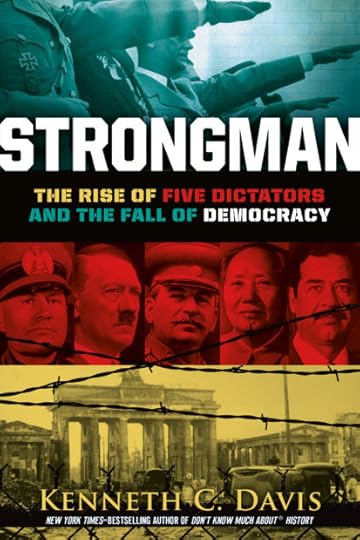
An audiobook is available from Penguin Random House
Strongman named among Washington Post Best Children’s and Young Adult Books of 2020 Named to “Best Children’s Books of the Year-2021” by the Bank Street College of EducationA Junior Library Guild “Gold Standard Selection” for “outstanding literary merit.” Named to “Best Young Adult Books of the Year” by Kirkus ReviewsNamed to “Best YA Books of 2020 for Understanding the US Today” Kirkus ReviewsStarred review from Kirkus Reviews: “History’s warnings reverberate in this gripping read about five dictatorial strongmen. A pitch-perfect balance of nuanced reflection and dire warning.” Read the full review hereStarred Review from Publishers Weekly: “A fascinating, highly readable portrayal of infamous men that provides urgent lessons for democracy now.” Read the full review hereStarred Review from Shelf Awareness: “Kenneth C. Davis…conveys his plentiful knowledge of dictators in this powerful, spine-tingling biographic work that covers five of the world’s most horrifying autocrats. Grounded in thorough research, Strongman expertly explores the fragility of democracy …” Read the full review here
Named to “Best Young Adult Books of the Year” by Kirkus ReviewsNamed to “Best YA Books of 2020 for Understanding the US Today” Kirkus ReviewsStarred review from Kirkus Reviews: “History’s warnings reverberate in this gripping read about five dictatorial strongmen. A pitch-perfect balance of nuanced reflection and dire warning.” Read the full review hereStarred Review from Publishers Weekly: “A fascinating, highly readable portrayal of infamous men that provides urgent lessons for democracy now.” Read the full review hereStarred Review from Shelf Awareness: “Kenneth C. Davis…conveys his plentiful knowledge of dictators in this powerful, spine-tingling biographic work that covers five of the world’s most horrifying autocrats. Grounded in thorough research, Strongman expertly explores the fragility of democracy …” Read the full review here•2021 YALSA Nonfiction Award nominee
A review in Booklist says, “Davis does not sugarcoat his material, inviting long thoughts with his assertion that this is a decidedly human story that points to real people as evidence that evil exists in this troubled world.”
In addition to telling how these men took unlimited power, brought one-party rule to their nations, and were responsible for the deaths of millions of people, the book offers a brief history of Democracy and discusses the present threat to democratic institutions around the world.
In a time when Democracy is under assault across the globe, it is more important than ever to understand how a Strongman takes power and how quickly democracy can vanish –even as millions cheer its death.
ADVANCE PRAISE FOR STRONGMAN
“I found myself engrossed in it from beginning to end. I could not help admiring Davis’s ability to explain complex ideas in readable prose that never once discounted the intelligence of young readers. It is very much a book for our time.”
—Sam Wineburg, Margaret Jacks Professor of Education & History, Stanford University, author of Why Learn History (When It’s Already on Your Phone).
“Strongman is a book that is both deeply researched and deeply felt, both an alarming warning and a galvanizing call to action, both daunting and necessary to read and discuss.”
—Cynthia Levinson, author of Fault Lines in the Constitution: The Framers, Their Fights, and the Flaws That Affect Us Today
“A wake-up call to democracies like ours: we are not immune to despots . . . Strongman demonstrates that democracy is not permanent, unless it is collectively upheld. This book shakes that immortality narrative.”
—Jessica Ellison, President of the Minnesota Council for the Social Studies; Teacher Education Specialist, Minnesota Historical Society
“Rarely does a history book take such an unflinching look at our common future, where the very presence of democracy is less than certain; even rarer is a history book in which the author’s moral convictions incite young readers to civic engagement; rarest of all, a history book as urgent, as impassioned, and as timely as Kenneth C. Davis’ Strongman.”
—Eugene Yelchin, author of the Newbery Honor book Breaking Stalin’s Nose
The post STRONGMAN: The Rise of Five Dictators and the Fall of Democracy first appeared on Don't Know Much.
November 9, 2022
11-11-11: Don’t Know Much About Veterans Day-The Forgotten Meaning
“The eleventh hour of the eleventh day of the eleventh month.”
(This is a revised version of a post originally written for Veterans Day in 2011. The meaning still applies.)

Taken at 10:58 a.m., on Nov. 11, 1918, just before the Armistice went into effect; men of the 353rd Infantry, near a church, at Stenay, Meuse, wait for the end of hostilities. (SC034981)
On Veterans Day, a reminder of what the day once meant and what it should still mean.
That was the moment at which World War I –then called THE GREAT WAR– largely came to end in 1918, at the eleventh hour of the eleventh day of the eleventh month.
One of the most tragically senseless and destructive periods in all history came to a close in Western Europe with the Armistice –or end of hostilities between Germany and the Allied nations — that began at that moment. Some 20 million people had died in the fighting that raged for more than four years since August 1914. The formal end of the war came with the Treaty of Versailles in June 1919.
Today, it is important to recognize the role of that treaty and the war in the rise of some of the most murderous dictators in history. That history is told in my new book, Strongman: The Rise of Five Dictators and the Fall of Democracy.
Besides the war casualties, an estimated 100 million people died during the war of the Spanish flu, a worldwide pandemic that was completely linked to the war and had an impact on its outcome. That is the subject of my recent book, More Deadly Than War:The Hidden History of the Spanish Flu and the First World War.

The date of November 11th became a national holiday of remembrance in many of the victorious allied nations –a day to commemorate the loss of so many lives in the war. And in the United States, President Wilson proclaimed the first Armistice Day on November 11, 1919. A few years later, in 1926, Congress passed a resolution calling on the President to observe each November 11th as a day of remembrance:
Whereas the 11th of November 1918, marked the cessation of the most destructive, sanguinary, and far reaching war in human annals and the resumption by the people of the United States of peaceful relations with other nations, which we hope may never again be severed, and
Whereas it is fitting that the recurring anniversary of this date should be commemorated with thanksgiving and prayer and exercises designed to perpetuate peace through good will and mutual understanding between nations; and
Whereas the legislatures of twenty-seven of our States have already declared November 11 to be a legal holiday: Therefore be it Resolved by the Senate (the House of Representatives concurring), that the President of the United States is requested to issue a proclamation calling upon the officials to display the flag of the United States on all Government buildings on November 11 and inviting the people of the United States to observe the day in schools and churches, or other suitable places, with appropriate ceremonies of friendly relations with all other peoples.
Of course, the hopes that “the war to end all wars” would bring peace were short-lived. By 1939, Europe was again at war and what was once called “the Great War” would become World War I. With the end of World War II, there was a movement in America to rename Armistice Day and create a holiday that recognized the veterans of all of America’s conflicts. President Eisenhower signed that law in 1954. (In 1971, Veterans Day began to be marked as a Monday holiday on the third Monday in November, but in 1978, the holiday was returned to the traditional November 11th date).
Today, Veterans Day honors the duty, sacrifice and service of America’s nearly 25 million veterans of all wars, unlike Memorial Day, which specifically honors those who died fighting in America’s wars.
We should remember and celebrate all those men and women. But lost in that worthy goal is the forgotten meaning of this day in history –the meaning which Congress gave to Armistice Day in 1926:
to perpetuate peace through good will and mutual understanding between nations …
inviting the people of the United States to observe the day … with appropriate ceremonies of friendly relations with all other peoples.
The Library of Congress offers an extensive Veterans History Project.
Read more about World War I and all of America’s conflicts in Don’t Know Much About History and Don’t Know Much About the American Presidents.
I discuss the role of Americans in battle in more than 240 years of American history in THE HIDDEN HISTORY OF AMERICA AT WAR: Untold Tales from Yorktown to Fallujah (Hachette Books and Random House Audio).
MORE DEADLY THAN WAR: The Hidden History of the Spanish Flu and the First World War was published in May 2018. Strongman was published in 2020.


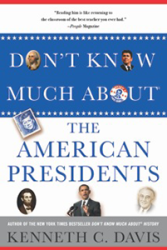
The post 11-11-11: Don’t Know Much About Veterans Day-The Forgotten Meaning first appeared on Don't Know Much.
October 24, 2022
STRONGMAN: The Rise of Five Dictators and the Fall of Democracy
STRONGMAN tells the real stories of the lives and times of five of the most deadly dictators of the 20th century — Mussolini, Hitler, Stalin, Mao Zedong, and Saddam Hussein.Order from Holt Books
An audiobook is available from Penguin Random House
Strongman named among Washington Post Best Children’s and Young Adult Books of 2020 Named to “Best Children’s Books of the Year-2021”
by the Bank Street College of EducationNamed to “Best Young Adult Books of the Year” by Kirkus ReviewsNamed to “Best YA Books of 2020 for Understanding the US Today” Kirkus ReviewsStarred review from Kirkus Reviews: “History’s warnings reverberate in this gripping read about five dictatorial strongmen. A pitch-perfect balance of nuanced reflection and dire warning.”Read the full review hereStarred Review from Publishers Weekly: “A fascinating, highly readable portrayal of infamous men that provides urgent lessons for democracy now.”Read the full review hereStarred Review from Shelf Awareness: “Kenneth C. Davis…conveys his plentiful knowledge of dictators in this powerful, spine-tingling biographic work that covers five of the world’s most horrifying autocrats. Grounded in thorough research, Strongman expertly explores the fragility of democracy …” Read the full review here
Named to “Best Children’s Books of the Year-2021”
by the Bank Street College of EducationNamed to “Best Young Adult Books of the Year” by Kirkus ReviewsNamed to “Best YA Books of 2020 for Understanding the US Today” Kirkus ReviewsStarred review from Kirkus Reviews: “History’s warnings reverberate in this gripping read about five dictatorial strongmen. A pitch-perfect balance of nuanced reflection and dire warning.”Read the full review hereStarred Review from Publishers Weekly: “A fascinating, highly readable portrayal of infamous men that provides urgent lessons for democracy now.”Read the full review hereStarred Review from Shelf Awareness: “Kenneth C. Davis…conveys his plentiful knowledge of dictators in this powerful, spine-tingling biographic work that covers five of the world’s most horrifying autocrats. Grounded in thorough research, Strongman expertly explores the fragility of democracy …” Read the full review here•2021 YALSA Nonfiction Award nominee
A review in Booklist says, “Davis does not sugarcoat his material, inviting long thoughts with his assertion that this is a decidedly human story that points to real people as evidence that evil exists in this troubled world.”
In addition to telling how these men took unlimited power, brought one-party rule to their nations, and were responsible for the deaths of millions of people, the book offers a brief history of Democracy and discusses the present threat to democratic institutions around the world.
In a time when Democracy is under assault across the globe, it is more important than ever to understand how a Strongman takes power and how quickly democracy can vanish –even as millions cheer its death.
ADVANCE PRAISE FOR STRONGMAN
“I found myself engrossed in it from beginning to end. I could not help admiring Davis’s ability to explain complex ideas in readable prose that never once discounted the intelligence of young readers. It is very much a book for our time.”
—Sam Wineburg, Margaret Jacks Professor of Education & History, Stanford University, author of Why Learn History (When It’s Already on Your Phone).
“Strongman is a book that is both deeply researched and deeply felt, both an alarming warning and a galvanizing call to action, both daunting and necessary to read and discuss.”
—Cynthia Levinson, author of Fault Lines in the Constitution: The Framers, Their Fights, and the Flaws That Affect Us Today
“A wake-up call to democracies like ours: we are not immune to despots . . . Strongman demonstrates that democracy is not permanent, unless it is collectively upheld. This book shakes that immortality narrative.”
—Jessica Ellison, President of the Minnesota Council for the Social Studies; Teacher Education Specialist, Minnesota Historical Society
Rarely does a history book take such an unflinching look at our common future, where the very presence of democracy is less than certain; even rarer is a history book in which the author’s moral convictions incite young readers to civic engagement; rarest of all, a history book as urgent, as impassioned, and as timely as Kenneth C. Davis’ Strongman.
—Eugene Yelchin, author of the Newbery Honor book Breaking Stalin’s Nose.
October 18, 2022
Pop quiz: What did Washington get when the British surrendered at Yorktown?
(Original post updated 10/18/2022)
Answer: All of the enslaved people in Yorktown who had escaped to the British in hopes of freedom.
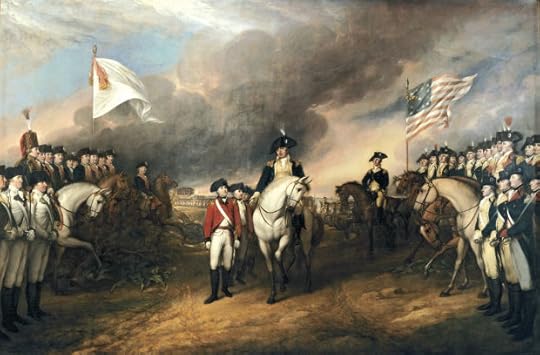
Surrender of Lord Cornwallis by John Trumbull (Source: Architect of the U.S. Capitol)
Left out of the picture are the Black people at Yorktown: enslaved people with the British, Black Continental Army soldiers who fought, and William Lee, the enslaved manservant of George Washington.
When the British forces under Cornwallis surrendered to George Washington and his French allies on October 19, 1781, the terms of capitulation included the following phrase
It is understood that any property obviously belonging to the inhabitants of these States, in the possession of the garrison, shall be subject to be reclaimed.
(Article IV, Articles of Capitulation; dated October 18, 1781. Source and Complete Text: Avalon Project-Yale Law School)
That “property” clearly meant the thousands of escaped enslaved people who had flocked to the British army during Cornwallis’s campaign in Virginia in what has been called the “largest slave rebellion in American history.”
They had come in the belief that the British would free them. Cornwallis had put them to work on the British defense works around the small tobacco port, and when disease started to spread and supplies ran low, Cornwallis forced hundreds of these people out of Yorktown. Many more died from epidemic diseases and the shelling of American and French artillery during the siege.
Nearly five years later, in April 1786, Washington wrote to financier Robert Morris regarding the problems for enslavers caused by Abolitionists in Philadelphia:
“I hope it will not be conceived from these observations, that it is my wish to hold the unhappy people who are the subject of this letter, in slavery. I can only say that there is not a man living who wishes more sincerely than I do, to see a plan adopted for the abolition of it—but there is only one proper and effectual mode by which it can be accomplished, & that is by Legislative authority: and this, as far as my suffrage will go, shall never be wanting.
But when slaves who are happy & content to remain with their present masters, are tampered with & seduced to leave them; when masters are taken at unawar[e]s by these practices; when a conduct of this sort begets discontent on one side and resentment on the other, & when it happens to fall on a man whose purse will not measure with that of the Society, & he looses his property for want of means to defend it—it is oppression in the latter case, & not humanity in any; because it introduces more evils than it can cure.”
Source: National Archives “Founders Online”
The African Americans in Yorktown included at least seventeen people who had left Washington’s Mount Vernon plantation with the British, as well as members of Thomas Jefferson’s enslaved community also captured earlier in 1781. They were all returned to bondage, along with thousands of others as Virginian slaveholders came to Yorktown to recover their “property.”
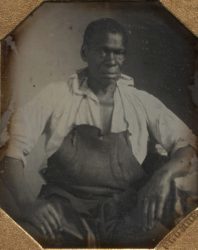
Isaac Granger Jefferson at about age 70 (Courtesy: Tracy W. McGregor Library of American History, Special Collections, University of Virginia Library)
Among them was Isaac Granger Jefferson, a five-year-old boy who was returned to Monticello and later told his story.
The stories of some of the people “reclaimed” by Washington are told in my book, IN THE SHADOW OF LIBERTY: The Hidden History of Slavery, Four Presidents, and Five Black Lives.

The Battle of Yorktown and role of African-American soldiers there –as well as the fate of the enslaved people in the besieged town — are featured in THE HIDDEN HISTORY OF AMERICA AT WAR: Untold Tales from Yorktown to Fallujah.

The Hidden History of America At War (paperback)
“A fascinating exploration of war and the myths of war. Kenneth C. Davis shows how interesting the truth can be.” –Evan Thomas, New York Times-bestselling author of Sea of Thunder and John Paul Jones
October 8, 2022
Columbus Day-The World Is a Pear
(Video edited and produced by Colin Davis; originally posted October 2011; revised October 2022)
Add me to the list. I think it is well past time that we ditched Columbus Day. Cities and states around the country are changing the name of the holiday to “Indigenous People’s Day” or “Native American Day” to move this holiday away from a man whose treatment of the natives he encountered included barbaric punishments and forced labor.
In writing about Columbus over more than thirty years, three points stand out when I consider this day that marks his arrival:
•the eradication of the native people he encountered and misnamed los indios through forced labor, executions, and the spread of diseases. (Read “Isabella’s Pigs” chapter in America’s Hidden History)
•the introduction of African slavery by the Spanish after the death of so many Native American people who had been forced into slavery by the Spanish demanded a new labor supply
•the carryover of Europe’s religious wars to the Americas (a subject also discussed in America’s Hidden History)
Aside from those big ripples of history, we have to unlearn a basic idea– that Columbus thought the world was round. He didn’t. And wrote as much.
I found it (the world) was not round . . . but pear shaped, round where it has a nipple, for there it is taller, or as if one had a round ball and, on one side, it should be like a woman’s breast, and this nipple part is the highest and closest to Heaven.
–Christopher Columbus, Log of his third voyage (1498)
To me this a lot more interesting than…
“In fourteen hundred and ninety-two/Columbus sailed the ocean blue.”
We all remember that much. But after that basic date, things get a little fuzzy. Here’s what they didn’t tell you–
*Most educated people knew that the world was not flat.
*Columbus never set foot in what would become America.
*Christopher Columbus made four voyages to the so-called New World. And his discoveries opened an astonishing era of exploration and exploitation. But his arrival marked the beginning of the end for tens of millions of Native Americans spread across two continents.
So how did we get a holiday for a man who thought the world was a pear?
In 1892, the 400th anniversary of the arrival of Columbus inspired the composition of the original Pledge of Allegiance and a proclamation by President Benjamin Harrison describing Columbus as “the pioneer of progress and enlightenment.” (Source: Library of Congress, “American Memory: Today in History: October 12”)
That was the patriotic American can-do spirit behind the Columbian Exposition—also known as the Chicago World’s Fair of 1893.
In 1934, the “progress and enlightenment” celebrated in the Columbus narrative was powerful enough to merit a federal holiday on October 12 – a reflection of the growing political clout of the Knights of Columbus, a Roman Catholic fraternal organization that fought discrimination against recently arrived immigrants, many of them Italian and Irish.
Once a hero. Now a villain. Calendars now add “Indigenous People’s Day” or “Native American Day” to shift this holiday away from a man whose treatment of the natives he encountered included barbaric punishments and forced labor.
“Indigenous Peoples’ Day recognizes that Native people are the first inhabitants of the Americas, including the lands that later became the United States of America. And it urges Americans to rethink history.”
–National Museum of the American Indian
Here are more resources on “Indigenous People’s Day” from the Teaching Tolerance organization
October 5, 2022
GREAT SHORT BOOKS: A Year of Reading–Briefly
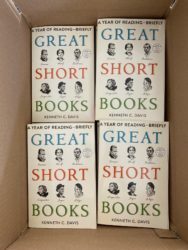
Bound galleys of Great Short Books have arrived!
COMING FROM SCRIBNER BOOKS
NOVEMBER 22, 2022
GREAT SHORT BOOKS:
A YEAR OF READING — BRIEFLY
“A must-purchase for public and school libraries.” ALA Booklist
Available for pre-order from Scribner/Simon & Schuster and Simon Audio (Unabridged audio download)
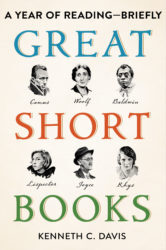
FIRST TRADE REVIEWS FROM KIRKUS, PUBLISHERS WEEKLY, BOOKLIST
“Davis feels that novels of 200 pages or less often don’t get the recognition they deserve, and this delightful book is the remedy…A must-purchase for public and school libraries.” *Starred Booklist review
“An entertaining journey with a fun, knowledgeable guide…. His love of books and reading shines through. From 1759 (Candide) to 2019 (The Nickel Boys), he’s got you covered.” –Kirkus Reviews
Full KIRKUS review here
“Davis’s conversational tone makes him a great guide to these literary aperitifs. This is sure to leave book lovers with something new to add to their lists.” FULL PUBLISHERS WEEKLY REVIEW here
During the lock-down, I swapped doom-scrolling for the insight and inspiration that come from reading great fiction. Inspired by Boccaccio’s “The Decameron” and its brief tales told during a pandemic, I read 58 great short novels –not as an escape but an antidote.
“A short novel is like a great first date. It can be extremely pleasant, even exciting, and memorable. Ideally, you leave wanting more. It can lead to greater possibilities. But there is no long-term commitment.”
–From “Notes of a Common Reader,” the Introduction to Great Short Books
The result is a compendium that goes from “Candide” to Colson Whitehead, and Edith Wharton to Leïla Slimani. And yes, Maus and many other Banned Books and Writers.

What “A Year of Reading–Briefly” looks like

Voltaire in Great Short Books
Art © Sam Kerr

Edith Wharton in Great Short Books
Art © Sam Kerr
Advance Praise for Great Short Books: A Year of Reading—Briefly
“GREAT SHORT BOOKS is a fascinating, thoughtful, and inspiring guide to a marvelous form of literature: the short novel. You can dip into this book anywhere you like, but I found myself reading it cover-to-cover, delighting in discovering new works while also revisiting many of my favorites. GREAT SHORT BOOKS is itself a great book—for those who are over-scheduled but want to expand their reading and for those who will simply delight in spending time with a passionate fellow reader who on every page reminds us why we need and love to read.”
–Will Schwalbe, New York Times bestselling author of THE END OF YOUR LIFE BOOK CLUB
“This is the book that you didn’t know you really needed. I began digging into this book as soon as I got it, and it was such a delight to read beautiful prose, just a sip at a time, with Kenneth Davis’ notes to give me context and help me more fully appreciate the stories. Keep this book near your bed or on your coffee table. It will be read and loved.”
–Celeste Headlee, journalist and author of WE NEED TO TALK and SPEAKING OF RACE

Recording audiobook of Great Short Books (Sept. 2022) Photo by Katherine Cook
From hard-boiled fiction to magical realism, the 18th century to the present day, Great Short Books spans genres, cultures, countries, and time to present a diverse selection of acclaimed and canonical novels—plus a few bestsellers. Like browsing in your favorite bookstore, this eclectic compendium is a fun and practical book for any passionate reader hoping to broaden their collection— or anyone who is looking for an entertaining, effortless reentry into reading.
And Indie booksellers weigh in:
“Need something grand, something classic, uh…. something short to read, but don’t know where to start? Check out Kenneth Davis’s guide to Great Short Books and you’ll soon find just the right tale to delight your literary palate. For each suggestion, Davis gives us first lines, a plot summary, an author’s bio, a reason for reading it, and, finally, what you should read next from the author’s canon. Pick up a copy… you’ll be glad you did. You’re welcome!”—Linda Bond, Auntie’s Bookstore (Spokane, WA)
“Kenneth Davis has presented the perfect solution for too many books, not enough time—a collection of exceptional short books perfect for reading in a society seemingly without any free time. Many of the books may be familiar by name, some are obscure, some even forgotten, but all belong in the canon of superb literature. He teases with a brief synopsis and explains why each book deserves attention. An absolutely intriguing bonus is a short biographical sketch of each author, many of whom had fascinating but traumatic lives. It is the perfect book to provide comfort literature for busy readers.”—Bill Cusumano, Square Books (Oxford, Miss.)
More early reviews from readers at NetGalley.com
“GREAT SHORT BOOKS is a wonderful, breezy but deep look at the outstanding short books of the last 150 years. Kenneth C. Davis is a genius at summarizing each book and making the reader want to read said book post haste. This is a book I didn’t know the world needed but the world did.” –Tom O., reviewer
“…an incredibly valuable tool for book clubs and readers everywhere! Some authors/titles are well-known and others will be new discoveries….HIGHLY RECOMMENDED for any book group looking to find new titles or any reader who wants to know what to read next.” –Ann H. reviewer
“I found over a dozen new authors or titles I want to now read that were included in his main list, and the Further Reading at the end of each chapter and at the end of the volume itself.
As others have suggested, this is a great tool for Book Clubs!
Not Lit Crit, it is mostly focused on necessary, just-the-facts-mam information on one person’s reading of short books over a year. Well worth a read, and great for browsing!” –Stephen B., Librarian
“What better way to introduce new readers to more than 50 ‘short’ books. This handy book is full of non-spoiler descriptions and cultural context that situate these stories within our world.” –Kelsey W., librarian
S0urce: Great Short Books via NetGalley
I can’t wait to start talking about this book with readers everywhere.
Teachers, Librarians, Book Clubs and Other Learning Communities:
Invite me for a visit to your school, classroom, library, historical group, book club or conference.
When Robin Hood Was Blacklisted
“Censorship Divides Us–Books Unite Us” –Banned Books Week– September 18-24, 2022
Robin Hood was a Commie.
That, at least, is what an Indiana state textbook commissioner thought back in 1953. This official called for schools to ban books mentioning Robin Hood for the simple reason that Robin and his Merry Men robbed from the rich and gave to the poor. Their antics reeked suspiciously of godless Socialism.
It is easy to laugh off this overlooked history as an amusing bit of trivia. Except the Hoosier state assault on Robin Hood was part of a larger nationwide effort to ban books and suppress intellectual freedom. It was led by Senator Joseph McCarthy during the anti-Communist “witch hunts.” It targeted books, writers, and libraries both at home and around the world. And it holds pointed lessons about safeguarding democracy from the forces threatening it today.
After the 1947 blacklisting of the “Hollywood Ten” screenwriters by the House Un-American Affairs Committee (HUAC), Senator McCarthy emerged as the face and unrelenting voice of a crusade against Communist influences in America. In 1950, McCarthy claimed to possess an extensive list of Communists who worked in the State Department. Launching his war on alleged Communist infiltrators as chairman of a Senate committee on government operations, McCarthy was abetted by J. Edgar Hoover’s FBI. To be labeled a Communist was an accusation from which there was no escape. Claims of innocence or invoking the Fifth Amendment were tantamount to confession.
Set against the Korean War begun in 1950, and with the convictions of Alger Hiss that year for perjury over espionage and the Rosenbergs in 1951 for atomic spying, America’s fear of Communism spread like wildfire. Gaining an army of rabid followers, McCarthy’s crusade to root out subversives widened to focus intently on libraries, which were pressured to purge their collections of works by Marx. By 1952, the New York Times described a pervasive wave of educational book censorship in America. Around the country, self-appointed local committees— “volunteer educational dictators” in the words of one librarian—were coercing librarians to remove books considered “un-American,” the Times found.
This anti-Communist juggernaut was not only steam-rolling domestic libraries. McCarthy sent it on a road trip. In April 1953, McCarthy’s underlings, attorney Roy Cohn and associate David Schine, were dispatched to Europe. Part of their mission was to scrutinize U.S. Information Service libraries, created to provide war-ravaged countries with American books. McCarthy claimed that these collections held thousands of works by Communists. Targeting suspect authors, just as Hollywood had been purged of “Red” screenwriters, Cohn and Schine succeeded in intimidating foreign service officials. No fires were set, but titles by Dashiell Hammett, Lillian Hellman, and Howard Fast, among others, were pulled from the shelves.
Inaugurated in January 1953, President Eisenhower was hesitant to challenge McCarthy. But he discreetly fired back. He told a Dartmouth commencement audience in June of that year:
“Don’t join the book burners. Don’t think you are going to conceal faults by concealing evidence that they ever existed. Don’t be afraid to go in your library and read every book, as long as that document does not offend our own ideas of decency.”
–President Eisenhower, “Remarks at the Dartmouth College Commencement”
Unfortunately, Eisenhower’s defense of reading was less than full-throated. Ultimately, his State Dept. folded to McCarthy’s men.
“Only reckless men, under these conditions, could choose to take steps offensive to McCarthy since the President and the Secretary [of State John Foster Dulles] have rarely backed up their subordinates whom McCarthy has singled out for attack.”
—The New Republic June 29, 1953
But America’s librarians were not about to be silenced. Despite the stale caricature of an old lady in a bun shushing the patrons, many librarians spoke out, daringly, given the nation’s fearful mood and threats to their jobs. Responding to this mounting pressure, the American Library Association (ALA), in concert with the American Association of Publishers, issued in June 1953 a “Freedom to Read” statement –since revised several times—that begins, “The freedom to read is essential to our democracy. It is continuously under attack.”
Unfortunately, the ALA was right then—and now. Ike’s “book burners” are back—or perhaps it is more accurate to say they never left. Across America, a concerted effort to purge school and public libraries of “offensive” literature has found new vigor and a louder voice. There is a long history of attempts to rid libraries of books considered objectionable—it is the reason the ALA launched its annual Banned Books Week forty years ago to highlight local challenges to books. But these perennial community-level attempts to challenge books deemed “subversive” or “indecent” have reached a new level of intensity.
Currently, in America’s riven political ecosystem, the hyper-charged urge to purge has been fused with anger over vaccinations and mask mandates and the assault on teaching any American history that doesn’t fit a suitably patriotic mold. In such states as Florida, Texas, and Virginia, the backlash has grown intense and been wrapped in the pretense of giving parents “control” over their children’s education. The bullseye has moved from Robin Hood, The Communist Manifesto, and The Catcher in the Rye to a new set of targets. Many of the books now under fire deal with race, slavery, gender issues, and of course, sexuality.
Raising the fever pitch are books exploring gay relationships and gender identity. In November 2021, a Virginia school board member was quoted in press reports as saying, “I think we should throw those books in a fire.”In February, a Tennessee pastor went further, leading a book burning that saw Harry Potter and Twilight consigned to the flames—both among the usual suspects in recent book bans and challenges.
We’ve seen these flames before. In fiction, they raged in Ray Bradbury’s dystopic Fahrenheit 451 in which “firemen” burn outlawed books. Bradbury’s 1953 novel was written in large part as a reaction to the ongoing purges under McCarthy and his followers.
But these flames have also roared more frighteningly in fact. Book burnings are actually older than books, dating to ancient times in Greece and China. After Gutenberg’s printing revolution, the Vatican created the Index Librorum Prohibitorum, a catalog of banned books, some of which were burned, sometimes along with their authors—like Giordano Bruno in 1600.
Most notoriously in pre-World War II Germany, some 25,000 “un-German” books were consigned to Nazi bonfires in May 1933. Targeted by Hitler’s loyal disciples were works by German Jews and Marx, Freud, and Einstein. Books by German novelists Thomas Mann and Eric Maria Remarque—author of the World War I classic All Quiet on the Western Front— went into the flames along with such American writers as Ernest Hemingway, Jack London, and Helen Keller.
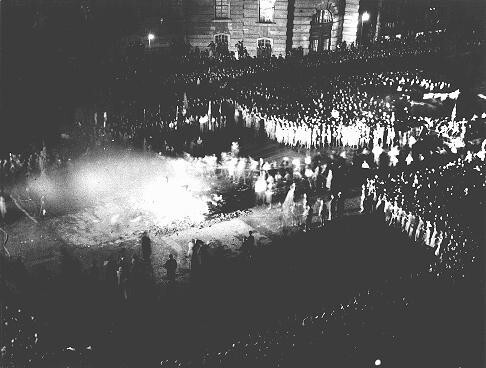
Book Burning May 10, 1933 Image courtesy US Holocaust Memorial Museum https://encyclopedia.ushmm.org/conten...
Can it happen here? It has.
Nearly a century before the Nazi book burnings, a concerted effort to flood the slaveholding states with abolitionist literature was met with fire. In the summer of 1835, an angry mob raided a Charleston, South Carolina post office and consigned thousands of abolitionist pamphlets to a bonfire. The book burning was topped off with an effigy of abolitionist William Lloyd Garrison being set ablaze. Garrison was lucky. Tragically, abolitionist publisher Elijah Lovejoy was not. Two years later, a mob intent on burning anti-slavery literature in Alton, Illinois murdered Lovejoy as he tried to defend his presses. A century later, in 1939, California growers burned Steinbeck’s Pulitzer Prize-winning The Grapes of Wrath.
Scrubbing the nation’s public square of “offensive” materials and torching books—despite the protections in the Bill of Rights—are as American as apple pie, lynch mobs, burning crosses, and now, tiki torches.
But there’s something new in the equation. The latest wave of book suppression is not simply about “subversion” or “dirty words.” Scratch the surface of recent book bans and it is clear that the assault on free expression cannot be separated from the larger Orwellian effort to sanitize American history, delegitimize literature by gay writers and people of color, and undermine democracy.
This revitalized onslaught carries the distinct whiff of white, Christian nationalism. This is the racial, cultural, and political ideology that once reared its head as nineteenth-century Nativism, the reinvigorated Ku Klux Klan of the 1920s, and the America Firsters of the 1930s.
Claiming that the United States is a “Christian nation,” this strand of anti-immigrant, anti-Catholic, and anti-Semitic American DNA is older than the nation itself. Time has not diminished its power. Now adding “globalists” to their enemies list, white Christian nationalism has been tied to the Charlottesville rioters who chanted “You will not replace us” and the January 6 insurrection by experts who study the movement.
America has no monopoly on this historically powerful faction. A form of white Christian nationalism, with its claims of racial superiority, certainly fed Hitler’s rise in Germany.
And that is why this revived wave of book suppression is a piece of a much larger development. The reason that Maus, a Pulitzer-Prize winning graphic novel-memoir about the Holocaust, was ostensibly pulled from schools in Tennessee was for some of its language and a discreet cartoon illustration of the author’s mother—an Auschwitz survivor—naked in the bathtub where she had committed suicide. But its critics apparently sought a kinder, gentler discussion of the Holocaust, although any attempts to soften that history tiptoe dangerously toward denialism. This is how history goes down 1984’s “Memory Hole.”
It is more than a little ironic that this onslaught of suppression comes as many on the Right decry the so-called “cancel culture” of the Left. Claiming their right to free speech is under attack, modern-day “book burners” crush that freedom under their boot heels as they attempt to distort or erase history and silence unwelcome voices. When such voices and ideas are deemed a threat and suppressed by the government, religious authorities, or a political party, we teeter on the thin ice of authoritarianism. The ice cracks when a fictional character is attacked—whether it is Homer Simpson, Huckleberry Finn, or Robin Hood. All three have come under fire over the years.
Banning books, legislating against “divisive concepts” in history class, and purging diversity all come straight from the playbook of the Strongman. He knows the power of the pen. Books make us think. Literature cultivates the free mind. Writers are truth-tellers. In 1917, Soviet leader Lenin ordered a “Decree on Press” threatening closure of publications critical of the Bolsheviks. Authoritarians know the danger posed by truth. And they are more than willing to use sword and flame to cut it down.
The question is what can we do about it?
“The antidote to authoritarianism is not some form of American authoritarianism,” Cooper Union librarian David K. Berninghausen told the Times in 1952. “The antidote is free inquiry.”
When Robin Hood was threatened by a textbook commissioner in 1953, some Indiana State University students fought back. Five of them gathered chicken feathers, dyed them green, and spread them across campus. Their protest caught on at other colleges, including UCLA, where two hundred students dressed up as Sherwood Forest’s Merry Men for a Green Feather drop. A clever, well-aimed protest, the Green Feather movement broke no windows or legs. Robin Hood was spared.
But those more innocent days are gone. In the internet age, the lines are more sharply drawn, sides set in stone, and the stakes much higher.
That is why dumping some green feathers or wearing an “I READ BANNED BOOKS” t-shirt will not be enough for this moment. If we care, we must take to heart Ike’s advice and “read every book.” We must firmly resolve to read. But buying and reading Maus or Toni Morrison’s Beloved are only the first steps.
We have to make sure that others can read these books. We must be audacious in support of free libraries and vigorously support all teachers who want to encourage students to read, debate, and think for themselves. And we must vigilantly push back on politicians and schoolboards purging libraries of uncomfortable truths. A few loud voices dominating a schoolboard or town hall meeting do not a majority make. To allow a noisy minority to dictate what we read and teach is skating on that thin ice of totalitarian loyalty oaths typical of a Mussolini or Stalin.
On this final note, history is clear. When you have succeeded in marking a writer as “degenerate” or “immoral”—as the Nazis did—you have moved towards dehumanizing them. It is a few short perilous steps from censorship to suppression to a conflagration far worse. In Berlin, on the spot where Nazis threw books into a bonfire, there is a plaque citing German playwright Heinrich Heine’s 1820 words, which read in part: “Where they burn books, they will ultimately burn people as well.”
The road to Hell is lit by burning books.
UPDATE: “Virginia Legal Action Threatens the Freedom to Read” (National Coalition Against Censorship)
“This legal action could profoundly limit the availability of books in the Commonwealth of Virginia. No book has been banned for obscenity in the United States in more than 50 years. Prohibiting the sale of books is a form of censorship that cannot be tolerated under the First Amendment.”
© Copyright 2022 Kenneth C. Davis All rights reserved
October 1, 2022
Remembering the Nuremberg Trials: A Don’t Know Much About® Audiominute
(Originally posted January 26, 2021; revision 10/1/2022)
On October 1, 1946, the verdicts in the first round of Nuremberg (“Nürnberg”) Trials were handed down.
As the Russian invasion and illegal “annexation” of Ukraine continue and the question of war crimes is in the air, it is instructive to look back at the most famous war crimes in history, the Nuremberg Trials of Nazis in the aftermath of the defeat of Nazi Germany. The U.S. delegation was led by Robert H. Jackson
For over a month, during the summer of 1945, representatives of the Soviet, French, U.S. and U.K. governments attempted to reconcile their conflicting legal concepts and devise a workable procedure for the trial. At the core of these intense negotiations was Robert H. Jackson. Jackson refused to back down on certain legal principles, most importantly, the position that aggressive warfare was an international crime.
‘Our view, is that this isn’t merely a case of showing that these Nazi Hitlerite people failed to be gentlemen in war; it is a matter of their having designed an illegal attack on the international peace.’ ”
The Nuremberg Trials — A Don’t Know Much About® Audiominute
On November 20, 1945, in the aftermath of World War II, the first trials of Nazi war criminals began. This military tribunal, the Nuremberg Trials, as they came to be known, was convened by the four victorious Allies—Great Britain, France, the Soviet Union, and the United States.
Listen to this audiominute.
https://dontknowmuch.com/wp-content/uploads/2020/11/New-Recording-9.m4a
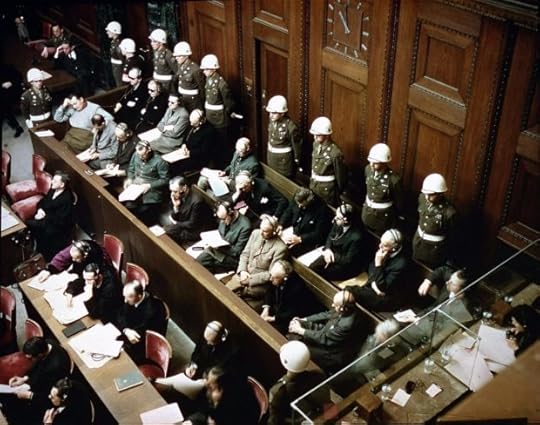
Defendants in the Dock at the Nuremberg Trials (Image: National Archives)
“That four great nations, flushed with victory and stung with injury stay the hand of vengeance and voluntarily submit their captive enemies to the judgment of the law is one of the most significant tributes that Power has ever paid to Reason.
What makes this inquest significant is that these prisoners represent sinister influences that will lurk in the world long after their bodies have returned to dust. We will show them to be living symbols of racial hatreds, of terrorism and violence, and of the arrogance and cruelty of power.”
-United States Prosecutor Robert Jackson, Opening Statement (11/21/1945)
Read Robert Jackson’s full opening statement here
On November 29, 1945, Day 8 of the Nuremberg Trials, a documentary film of the liberated concentration camps taken by American military photographers was shown. (Graphic images).
This is a timeline of the Nuremberg Trials from the Robert H. Jackson Center.
On the morning of Oct. 1, 1946, the Tribunal read the Judgment on the guilt or innocence of the individual defendants. 19 were found guilty on one or more counts of the Indictment. Three were acquitted: Schacht, Fritzche and von Papen.
After lunch on Oct. 1, 1946, Chief Justice Lawrence announced the sentences to the Defendants that were found guilty. Death by hanging: Goering, Ribbentrop, Keitel, Jodl, Kaltenbruner, Streicher, Rosenbeg, Frank, Frick, Sauckel, Bormann and Seyss-Inquart. Life: Hess, Raeder and Funk. Twenty Years: Speer and von Schirach. Fifteen years: von Neurath. Ten Years: Doenitz.
These resources on the Nuremberg Trials are from the Library of Congress.
This is an article about the Nuremberg Trials I wrote in 2005 for the Rutland (VT) Herald.
September 16, 2022
Constitution Day Pop Quiz: Who was the first man to sign the Constitution?
[Originally posted September 17, 2017]
Answer: On September 17, Washington signed the parchment copy first, as President of the convention.
On September 17, 1787, 39 delegates to the Constitutional Convention meeting in Philadelphia, voted to adopt the United States Constitution.
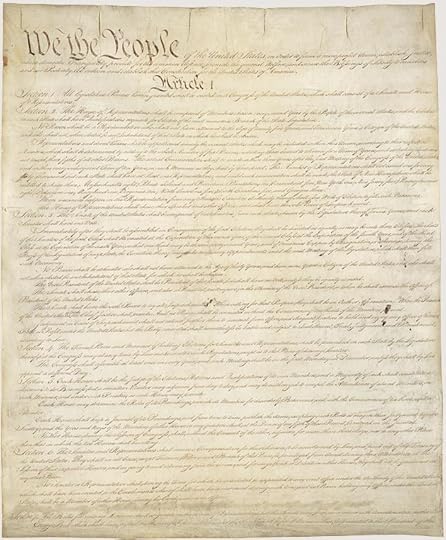
United States Constitution (Image Courtesy of the National Archives)
To recap these events:
Working from May 25, when a quorum was established, until September 17, 1787, when the convention voted to endorse the final form of the Constitution, the delegates gathered in Philadelphia’s Pennsylvania State House were actually obligated only to revise or amend the Articles of Confederation. Under those Articles, however, the government was plagued by weaknesses, such as its inability to raise revenues to pay its foreign debts or maintain an army. From the outset, most the convention’s organizers, James Madison chief among them, knew that splints and bandages wouldn’t do the trick for the broken Articles.
The government was broke –literally and figuratively– and they were going to fix it by inventing an entirely new one. James Madison had been studying more than 200 books on constitutions and republican history sent to him by Thomas Jefferson in preparation for the convention. The moving force behind the convention, Madison came prepared with the outline of a new Constitution.
A reluctant George Washington, whose name was placed at the head of list of Virginia’s delegates without his knowledge, was unquestionably spurred by recent events in Massachusetts (Shay’s Rebellion, a violent protest by Massachusetts farmers). Elected president of the convention, he wrote from Philadelphia in June to his close wartime confidant and ally, the Marquis de Lafayette:
I could not resist the call to a convention of the States which is to determine whether we are to have a government of respectability under which life, liberty, and property will be secured to us, or are to submit to one which may be the result of chance or the moment, springing perhaps from anarchy and Confusion, and dictated perhaps by some aspiring demagogue.
On September 17, Washington signed the parchment copy first, as President of the convention. He was followed by the remaining delegates from the twelve states that sent delegates in geographical order, from north to south, beginning with New Hampshire. (Rhode Island was the only state that did not send a delegation.) When the last of the signatures was added –that of Abraham Baldwin of Georgia– Benjamin Franklin gazed at Washington’s chair, on which was painted a bright yellow sun. He then spoke, as James Madison recorded it:
I have, said he, often in the course of a session, and the vicissitudes of my hopes and fears as to its issue, looked at that behind the President without being able to tell if it was rising or setting: But now at length I have the happiness to know that it is a rising and not a setting sun.
In another perhaps more apocryphal tale, Franklin left the building and was confronted by a lady who asked, “Well Doctor, do we have a monarchy or a republic?” The witty sage of Philadelphia replied,
“A republic, madam, if you can keep it.”
This post is excerpted from America’s Hidden History, which offers fuller account of the Convention and the events that led to it. You can also read more about the Constitutional Convention and the Constitution in Don’t Know Much About History: Anniversary Edition, Don’t Know Much About the American Presidents and In the Shadow of Liberty.
For more about the Constitution, visit these sites:
The National Constitutional Center in Philadelphia and James Madison’s Montpelier

Don’t Know Much About® the American Presidents (Hyperion paperback-April 15, 2014)

Don’t Know Much About® History: Anniversary Edition

New York Times Bestseller
America’s Hidden History

The post Constitution Day Pop Quiz: Who was the first man to sign the Constitution? first appeared on Don't Know Much.
September 15, 2022
Who Said It? 10/28/2021
President Dwight D. Eisenhower (June 14, 1953)

President Eisenhower (Courtesy: Eisenhower Presidential Library and Museum)
In 1953, Senator Joseph McCarthy, with assistance from FBI Director J. Edgar Hoover, campaigned to suppress books hinting at any connection to Socialism or Communism.
In April 1953, two of McCarthy’s underlings, Roy Cohn and David Schine, were dispatched to Europe, partly to scour U.S. Information Service libraries. Created to provide war-ravaged countries with American books, these collections – McCarthy claimed – held thousands of works by Communists. Intimidated by McCarthy’s men, foreign service officials removed titles by, among others, the blacklisted writers Dashiell Hammett, Lillian Hellman, and Howard Fast.
Reluctant to challenge the powerful Senator, Eisenhower offered these words to a commencement audience at Dartmouth:
Look at your country. Here is a country of which we are proud, as you are proud of Dartmouth and all about you, and the families to which you belong. But this country is a long way from perfection–a long way. We have the disgrace of racial discrimination, or we have prejudice against people because of their religion. We have crime on the docks. We have not had the courage to uproot these things, although we know they are wrong. And we with our standards, the standards given us at places like Dartmouth, we know they are wrong.
Now, that courage is not going to be satisfied–your sense of satisfaction is not going to be satisfied, if you haven’t the courage to look at these things and do your best to help correct them, because that is the contribution you shall make to this beloved country in your time. Each of us, as he passes along, should strive to add something.
It is not enough merely to say I love America, and to salute the flag and take off your hat as it goes by, and to help sing the Star Spangled Banner. Wonderful! We love to do them, and our hearts swell with pride, because those who went before you worked to give to us today, standing here, this pride.
And this is a pride in an institution that we think has brought great happiness, and we know has brought great contentment and freedom of soul to many people. But it is not yet done. You must add to it.
Don’t join the book burners. Don’t think you are going to conceal faults by concealing evidence that they ever existed. Don’t be afraid to go in your library and read every book, as long as that document does not offend our own ideas of decency. That should be the only censorship.
“Remarks at the Dartmouth College Commencement Exercises”
Source and complete text: Dwight D. Eisenhower, Remarks at the Dartmouth College Commencement Exercises, Hanover, New Hampshire. Online by Gerhard Peters and John T. Woolley, The American Presidency Project
It is also worth noting that Eisenhower’s words did not translate into much action. U.S. Information Services libraries were stripped of thousands of titles.
The post Who Said It? 10/28/2021 first appeared on Don't Know Much.



